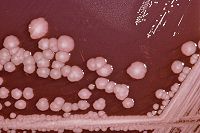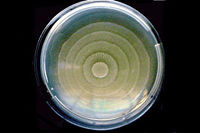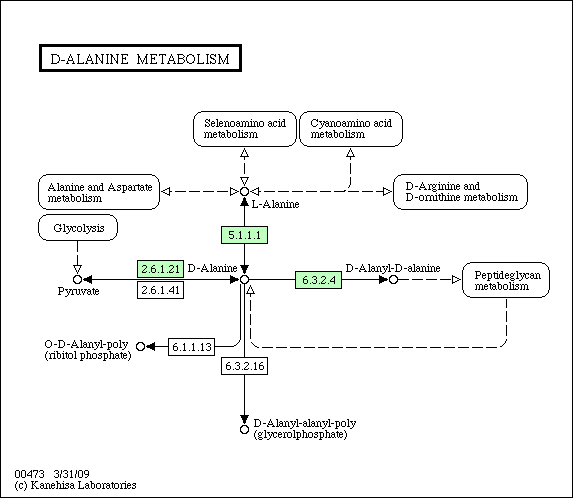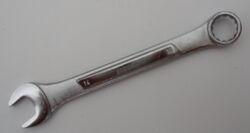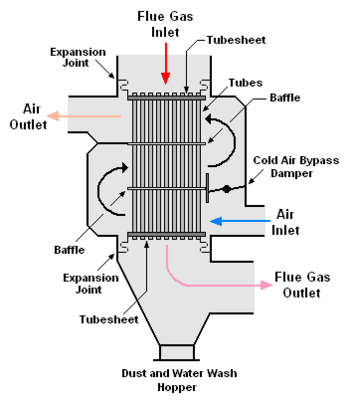Archive:New Draft of the Week
The New Draft of the Week is a chance to highlight a recently created Citizendium article that has just started down the road of becoming a Citizendium masterpiece.
It is chosen each week by vote in a manner similar to that of its sister project, the Article of the Week.
Current Nominees
The next New Draft of the Week will be the article with the most votes at 1 AM UTC on Thursday, 11 June 2009. I did the honors this time. Milton Beychok 07:06, 5 June 2009 (UTC)
Text in this section is transcluded from the respective Citizendium entries and may change when these are edited.
| Nominated article | Supporters | Specialist supporters | Dates | Score | |||||||||||||||||||||||||||||||||||||||||||||||||||||||||||||||||||||||||||||||||||||||||||||||
|---|---|---|---|---|---|---|---|---|---|---|---|---|---|---|---|---|---|---|---|---|---|---|---|---|---|---|---|---|---|---|---|---|---|---|---|---|---|---|---|---|---|---|---|---|---|---|---|---|---|---|---|---|---|---|---|---|---|---|---|---|---|---|---|---|---|---|---|---|---|---|---|---|---|---|---|---|---|---|---|---|---|---|---|---|---|---|---|---|---|---|---|---|---|---|---|---|---|---|---|
Proteus mirabilis is a Gram-negative, rod-shaped bacterium belonging to the enterobacteriaceae family.[1] It is facultatively anaerobic, not requiring oxygen for survival and reproduction and may even die in the presence of oxygen. Proteus mirabilis are found free-living in moist habitats, such as [water] and soil. They are mostly inhabitants of urinary tracts of human where they cause infections that are related with formation of renal and bladder calculi, also known as bladder stones. It is a significant, if not highly lethal, pathogen of humans, most often in the urinary tract. This species causes 90% of human Proteus infections and is usually community-acquired. P. vulgaris is more likely to be hospital-acquired (i.e., nosocomial). Genome structureSimilarly to other Gram-negative bacteria, Proteus mirabilis contains an extracytoplamic outer membrane. In addition, the outer membrane contains a lipid bilayer, lipoproteins, polysaccharides, and lipopolysaccharides.[1] Various components of the membrane interplay with the host to determine virulence. Proteus mirabilis possesses flagella which play an important role in the bacteria's swarming motility and pathogenicity.[2] Its genome has been completely sequenced. Pearson says. "Part of our goal is finding potential targets for new vaccines that could protect people from infection." In cases where stones form, the bacteria can become resistant to antibiotics," says Harry L.T. Mobley, Ph.D., professor and chair of microbiology and immunology in the U-M Medical School. Mobley is an expert on urease. Pearson's study explains why the bacterium has the ability to stick to some surfaces such as those of kidney or bladder stones. "This bacterium has an unusually high number of genes that encode for 15 different adherence factors or fimbriae on its surface," Pearson explains. "All these different fimbriae help the bacterium stick to bladder cells, catheters, kidney stones or each other. Pearson also discovered that the Proteus mirabilis genome is made up of 24 genes that encode components of a system used to inject bacterial proteins into host cells. In future research, Pearson will use gene micro arrays to identify the Proteus mirabilis genes that are turned on, or expressed, during the infection stage. Genes involved in the infection process will be prime targets for future vaccine development, according to Pearson, although she says that years of additional research will be needed before vaccines could be commercially available.[3] The genome of Proteus mirabilis is .063 Mb long and has a G+C content of 38.88%. There is a single plasmid consisting of 36,289 nucleotides. Annotation of the genome is identified 3,685 coding sequences and seven rRNA loci. Analysis of the sequence confirmed the presence of previously identified virulence determinants, as well as a contiguous 54-kb flagellar regulon and 17 types of fimbriae. Genes encoding a potential type III secretion system were identified on a low-G+C-content genomic island containing 24 intact genes that appear to encode all components necessary to assemble a type III secretion system needle complex. In addition, the P. mirabilis HI4320 genome possesses four tandem copies of the zapE metalloprotease gene, genes encoding six putative autotransporters, an extension of the atf fimbrial operon to six genes, including an mrpJ homolog, and genes encoding at least five iron uptake mechanisms, two potential type IV secretion systems, and 16 two-component regulators.[4] MorphologyProteus can display two different morphological and physiological forms; one is known as the swimmer cells and the other as swarmer cells. In aqueous suspension Proteus mirabilis is found in the swimmer state, which is a small rod-like cells1 to 2 μm in length. They contain 8 to 10 flagella that aid in their swimming motility. On contact with a surface, Proteus mirabilis changes to the swarmer state where the cell considerably increases in length to form highly flagellated filaments that are 20 to 80 μm in length. These cells line up in parallel to form rafts that are able to move rapidly over surfaces en masse. On semi-solid surfaces such as an agar surface, they form concentric rings of growth. This pattern is caused by the coordinated burst of swarming activity interspeded with a consolidation to the swimmer state..[5] An important feature of Proteus mirabilis is their swarming motility, facilitated by peritrichous flagella, which is a rapid and coordinated translocation of a bacterial population across solid or semi-solid surfaces. This ability aids them in food acquisition, reproduction and growth. It also aids the bacteria in expressing its virulence factors and invading hosts’ urothelial cells. MetabolismThey have the ability to produce urease, which is an enzyme that hydrolyzes urea to ammonia. In fact, Proteus mirabilis utilizes urea and citrate. It is therefore trivial for them to live in highly alkalinated environments. The bacterium also produces hydrogen sulfide gas, which aids in forming clear films on growth media, which can be distinguished as growth or concentric rings.[5]. EcologyProteus mirabilis are found free-living in moist habitats, such as water and soil. They are also found in putrid meat, infusions, and abscesses. They are mostly inhabitants of urinary tracts of human where it is believed to cause urinary tract infections associated with formation of renal and bladder calculi, often known as bladder stones. Proteus mirabilis require an environment that has high alkalinity, meaning that the concentration of alkali in the solution, which is measured in terms of pH, must be high. A suitable environment for Proteus mirabilis must have a pH higher than 7.[1] PathologyThis organism causes 90% of human infections with Proteus species. It is primarily community-acquired, and most frequent in the urinary tract. [1] Proteus mirabilis is a significant pathogen of the urinary tract. Urinary tract infection is a process following certain steps; it first starts with colonization of the bladder, which causes cystitis. Then, the infection proceeds to the kidneys, which leads to acute pyelonephritis, chronic inflammation and at last renal failure, which if left untreated, can cause death.[2] Proteus mirabilis is highly virulent and contains many characteristics that aid in its pathogenicity. It possesses a flagella which is necessary for motility and is involved in causing infections. It also produces urease, which is responsible for the formation of bladder and kidney stones as a result of the hydrolysis of urea to ammonia. Furthermore, the hemolysin that the bacterium secretes is cytotoxic for urinary tract epithelial cells which are subject to invasion by the proteus.[2] The bacterium's swarming motility also plays an important role in renal infections, which involve colonization of the lower urinary tract, followed by ascending movement of the bacterium. It is believed that the swarming motility is correlated with the effective invasion of hosts’ epithelia cells, as it provides the ability to move rapidly and therefore to rapidly colonize and invade the cells. Inhibition of virulence factor expression and swarming differentiation of Proteus mirabilis by p-nitrophenylglycerol (PNPG)It was found that PNPG could prevent Proteus mirabilis from growing and moving rapidly. according to a journal, PNPG inhibits the growth rate and swarming differentiation and activities of Proteus mirabilis. PNPG also inhabits the production of virulence factors such as urease, protease and hemolysin. It was found that in the presence of PNPG, the invasion hosts' epithelial cells diminished dramatically. This is due to the fact that PNPG contains certains agents that impair the proper function of Proteus mirabilis; the clinical significance needs to be assessed.[2] Reference
|
Milton Beychok | Daniel Mietchen | 4
| ||||||||||||||||||||||||||||||||||||||||||||||||||||||||||||||||||||||||||||||||||||||||||||||||
A wrench (American English), or spanner (British English), is a fastening tool used to manipulate threaded fasteners such as nuts, studs and bolts. They also may manipulate threaded structural elements such as pipes. The wrench is sized and shaped to put pressure and leverage on flat faces of the fastener, and then is moved in the direction of rotation needed to loosen or tighten the fastening assembly. Hand toolsThe most common hand wrenches are made either from a flat bar of steel, or from cylinders. Even with these two types, the wrench can either completely or partially surround the fastener. Flat BarThe most common hand wrenches either are open-ended, such that they have sides parallel to two or more facets of the nut, or box, which surrounds all sides of the nut. These types can drop over the nut no matter how much of the screw or bolt protrudes. The longer the handle of the wrench, the more force can be applied to the fastener. One technique is to carry a length of pipe, which can slip over the wrench and act as a handle extender. Do be warned, however, that a sufficiently long pipe can exert enough force to break the wrench or the fastener. Still, there are times when it is absolutely necessary to release a stuck fastener. It is usually wise first to apply a penetrating lubricant to the fastener, and tap it gently to let the lubricant reach the threads, waiting briefly before applying force. Yet another dangerous but sometimes necessary technique is to hit the handle of the wrench with a hammer; do remember to hit it in the direction in which the fastener needs to turn. Gloves and eye protection are wise precautions when hammering a wrench. An even more desperate expedient is to heat the fastener to expand it, which may destroy the hardness or toughness of the metal. Occasionally, it is possible to chill the piece to which the fastener is attached, contracting it and helping break the adhesion. For some specialized applications, typically where only authorized persons are to adjust the fastener, the sides of the wrench head may not be parallel. For example, the nuts on fire hydrants are pentagonal, so they cannot be manipulated with a standard wrench shape. Combination wrenchA combination wrench has a one open and one box end, usually of the same size. The open end is more useful when there is limited access to the fastener. Box ends can get a better grip when the flats of the nut are deformed.Adjustable open wrenchAn adjustable wrench has one fixed jaw, and one that is adjustable by means of a screw adjustment, usually made in one piece with the adjustable jaw. In the U.S., this is often called a Crescent wrench after the first well-known manufacturer, while it is a Bahco wrench in Dutch usage, after the Swedish manufacturer. The obvious advantage of the adjustable wrench is that an entire set of wrenches need not be carried when the size of the fastener to be adjusted is not known. The disadvantage is that the adjustment can slip, and generally cannot apply as much force as a solid wrench. It should be mentioned, if mostly to condemn the practice, that pliers are sometimes used to adjust nuts. Most types of pliers, however, do not have parallel jaws, but angled ones. These are apt to deform a nut if heavy pressure is applied. Pipe wrenchPipe wrenches grasp threaded pipes and turn them, so they do not have flat jaws. One common type has curved jaws, with the wrench designed to slip slightly so it can be repositioned as the pipe moves under it. These were called Stillson wrenches after the inventor; they are sometimes, incorrectly, called monkey wrenches. Another type does not have jaws, but instead a chain that tensions against the pipe. Some plumbing fixtures have a nut-like shape molded into the metal, so that a flat-jawed wrench can be used. This is the application intended for the increasingly rare monkey wrench. Socket wrenches and nutdriversSockets proper are single pieces of cast or machined metal, with one end shaped to slip over the fastener to be manipulated, and the other to receive a driveshaft to turn it. The shaft end may actually have a depression, or even a spring-loaded bearing, to help lock the shaft into place. In combination, the driveshaft and socket are extremely strong in rotation, but should separate easily with linear traction. Where the English measurement system is used, the shaft diameter is most often 3/8" or 1/4" for general purposes. 1/2", 3/4", and 1" drives are used for heavy equipment. Both metric and English system sockets, however, can snap onto the male end of the shaft. Adapters are available to convert between shaft sizes. For example, one might have a large nut but only a 1/4" shaft system, so an adapter can allow a 3/8" socket to be used with that shaft. Basic handle and extensionThe most basic driver is a shaft with a handle, much like a screwdriver, but with a socket-mating connector rather than a screwdriver bit. Another very common variant, called an extension, has a male connector that mates with the socket at one end, and a female connector that accepts another socket tool at the other. Multiple extensions can be snapped together for extra length. NutdriversNutdrivers are a permanently attached set of socket, driveshaft, and handle. Some nutdrivers have hollow shafts, so bolt length protruding above the nut goes into the hollow and does not interfere with rotation. Aids to leverageMost often, however, at the end of the extension away from the socket, a tool to improve the leverage of driving is attached. One such tool is a ratchet, which, at first, looks like an open-ended or box wrench. The male connector, however, is attached to a disk and mechanical components inside the ratchet head. There is a small control that selects the direction (i.e., loosening or tightening) in which the socket is to be moved. Once that control is set, the ratchet moves freely in the other direction, so it can be repositioned easily; it is not necessary to have 360 degree access above the fastener -- just enough working space to move the ratchet handle. Other ways to improve leverage include various pivoting handles. One type looks like the brace (tool) used to drive hand drills; there is a socket fitting rather than a chuck at the working end. The operator holds a knob, fitted with bearings in which the shaft turns, and cranks a handle. Another type, called a flex handle, is related to the rachet, but, rather than rotating, the handle pivots 180 degrees so it can be repositioned quickly. A flex handle is simpler, cheaper, and may be able to apply more force than a rachet. Torque wrenchesA torque wrench is both a fastening tool and a measuring device. It is used where precise measurement of the tightness of a bolt is necessary. It has been suggested that a quantum mechanical torque wrench can measure either the torque, or find the bolt, but not both. Spanners (precision)While a spanner is a general term in British English for "wrench", there is a specialized tool always known as a spanner. It consists of a bar with two or more protruding pins, sometimes adjustable in distance, that fit into corresponding holes in a fastener an allow it to be turned. The bar is connected to a shaft or other mechanism to allow turning, or sometimes the spanner is built not as a bar, but as a pliers-like device with the pins at the work end. Spanners are often used in optical work, on the retaining rings of lens elements. Power wrenchesImpact wrenchesOne of the most common types is a power-operated driver for sockets, the sockets usually made of extra-strong metal. Pneumatically driven impact wrenches are extremely common in the automotive industry; air drive does not generate the sparks that an electric motor could produce, which would be hazardous in the presence of petroleum products. For other applications, however, electric impact wrenches are increasingly common, especially cordless battery-powered wrenches with great portability. For some heavy applications, the impact energy may be provided by an explosive cartridge. There are impact wrenches that are hand-powered, but by hitting a specific part with a hammer, allowing great force to be applied. Power torque wrenchIntended for industrial applications, these are often powered hydraulically, which allows great precision. (Read more...) |
Howard C. Berkowitz | 3
| |||||||||||||||||||||||||||||||||||||||||||||||||||||||||||||||||||||||||||||||||||||||||||||||||
Current WinnerTo change, click edit and follow the instructions, or see documentation at {{Featured Article}}.
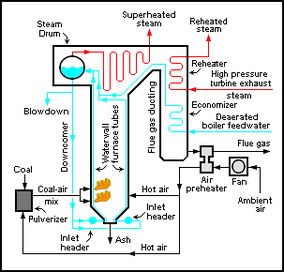 (PD) Image: Milton Beychok Schematic diagram of a steam generator in a conventional coal-fired power plant. An air preheater (APH) is a general term to describe any device designed to preheat the combustion air used in a fuel-burning furnace for the purpose of increasing the thermal efficiency of the furnace. In particular, this article describes the combustion air preheaters for the large fuel-burning furnaces used to generate steam in thermal power plants. The air preheater increases the steam generator's thermal efficiency by preheating the combustion air with heat recovered from the hot combustion flue gases (see the adjacent diagram). TypesThe two most often used categories of air preheaters in thermal power plants are regenerative air preheaters and tubular air preheaters.[1][2][3][4] Regenerative air preheatersThe two most common types of regenerative air preheaters are
Regenerative air preheaters may also be categorized as recuperators, which are special types of heat exchangers designed to recover or reclaim heat in order to reuse or recycle it. Rotating-plate regenerative air preheater (PD) Image: U.S. Environmental Protection Agency A typical rotating-plate regenerative air preheater.[2]  (PD) Image: U.S. Environmental Protection Agency A typical rotating-plate regenerative air preheater.[2]
In the tri-sector design, the steam generator's hot flue gas flows through the largest sector (usually spanning about half the cross-section of the casing) and transfers some of its heat into the heat-absorbing material within the rotating wheel element. The cooled flue gas is then routed to further treatment in dust removal and other equipment before being vented from the flue gas stack. Ambient air is blown through the second, smaller sector by a centrifugal fan and absorbs heat from the heated material as it rotates through that smaller sector. The heated air then flows into the steam generating furnace as combustion air. The third sector is the smallest one and it heats a portion of the ambient air which is then routed into the coal pulverizations and is used to transport the coal-air mixture to coal burners. Thus, the total air heated in the RAPH provides: heated primary combustion air, heated air to remove moisture from the pulverized coal and carrier air for transporting the pulverized coal to the coal burners. Since the flue gas pressure is lower than the pressure of the air being heated, there is some small leakage (between the sectors) of flue gas into the air. The bi-sector design is used in thermal power plants burning fuels (such as oil or gas) that do not require pulverizing or removal of moisture and therefore have need for heated air other than for combustion air. The quad-sector design has a large sector heated by flue gas and three air-heating sectors: one is for the combustion air and that sector is flanked by two smaller air sectors. In applications such as circulating fluid bed (CFB) combustion systems where the differential between the air pressure and the flue gas pressure is even higher than in a conventional coal-fired steam generator, flue gas pressure, such a design is ideal since it acts to reduce the leakage of air into the flue gas.[6] The rotating wheel element rotates quite slowly (around 3-5 revolutions per minute) to allow optimum heat transfer first from the hot exhaust gases to the element and then, as it rotates, from the element to the air in the other sectors. Construction featuresThe heat-absorbing material in the rotating wheel element consists of vertical corrugated plates pressed into steel baskets, with sufficient space between the plates for the flue gas to pass through. The plates are corrugated to provide more surface area for the heat to be absorbed and also to provide needed rigidity. The baskets are designed to be replaceable as needed. The vertical shaft that rotates the wheel is supported on thrust bearings at the lower end lubricated with an oil bath that is cooled by water circulating in coils inside the oil bath. Cooling of the bottom end of the shaft is needed since that is where the hot flue gas enters the preheater. The top end of the shaft has a simple roller bearing to hold the shaft in a vertical position. Radial supports and cages for holding the corrugated plate baskets in position are attached to the rotating shaft. Radial and circumferential seal plates are also provided to minimize leakage of flue gas or air between the sectors. For cleaning of the baskets while in operation, steam jets are provided to blow any fly ash (deposited by the flue gas) into an ash hopper below the preheater. The rotating shaft is driven by a motor and gearing. To avoid uneven thermal expansion and contraction resulting in damage to the rotating wheel, the rotation must be started before starting the steam generator and must also be kept in rotation for some time after the steam generator is shut down. The baskets of corrugated plates are subject to abrasive and corrosive wear from the fly ash and corrosive gases in the flue gas. Hence frequent replacements are required and new baskets are always kept on hand and ready for use. Stationary-plate regenerative air preheaterThe heat absorbing element in this type of regenerative air preheater is stationary rather than rotating. Instead, the air ducts in the preheater are rotated so as to alternately expose sections of the heating absorbing element to the upflowing air. The hot flue gas enters at the top of the preheater and flows down through those exposed sections of the stationary heat-absorbing element that are not blocked by the rotating air outlet ducts, thus heating those sections of the stationary element. As the air ducts slowly rotate around, they pass over the heated sections and the incoming air is heated as it flows upward through those heated sections. As indicated in the adjacent drawing, there are rotating inlet air ducts (inside the outer casing) at the bottom of the stationary heat absorbing element as well as the rotating outlet air ducts at the top of the stationary element. The basic heat transfer principals of the stationary-plate regenerative preheater are the same as for the rotating-plate regenerative preheater. The table below provides a comparison of some design parameters between the rotating-plate and stationary-plate preheaters:
Tubular typeTubular air preheaters may have a number of configurations:[2][8][9]
A number of new circulating fluid bed (CFB) and bubbling fluid bed (BFB) steam generators are using tubular air preheaters, which avoids the air leakage associated with regenerative air preheaters. Dew point corrosionThe water dew point of air or any other gas containing water vapor usually refers to the temperature (for a given pressure) at which the air or gas is saturated with water vapor. That means that the air or gas is at the point where the water vapor will start to condense into liquid water if the temperature is lowered beyond that point. As a broad generality, the combustion flue gases from steam generators fueled by coal, fuel oil, natural gas, or biomass are composed of carbon dioxide (CO2) and water vapor (H2O) as well as nitrogen and excess oxygen remaining from the intake combustion air. Typically, more than two-thirds of the flue gas is nitrogen. The combustion flue gases may also contain small percentages of air pollutants such as particulate matter, carbon monoxide, nitrogen oxides, and sulfur oxides in the form of gaseous sulfur dioxide (SO2) and gaseous sulfur trioxide (SO3). The SO3 is present because a portion of the SO2 formed in the combustion of the sulfur compounds in the steam generator's furnace fuel is further oxidized to SO3 as the flue gas travels through the superheater and reheater sections of the steam generator (see the above diagram of a steam generator). The gas phase SO3 then combines the vapor phase H2O to form gas phase sulfuric acid H2SO4:[10]
Because of the presence of gaseous sulfuric acid, the dew point of most flue gases is much higher than the water dew point of air and the flue gas dew point is referred to as the acid dew point. That is the flue gas temperature at which acid will begin to condense out of the flue gas if the temperature is lowered beyond that point. For example, a flue gas with 5 volume % water vapor and containing no acid gases has a water dew point of about 32 °C (90 °F). The same flue gas with the addition of only 0.01 volume percent of SO3 will have an acid dew point of about 118 °C (244 °F).[11] The acid dew point of a combustion flue gas depends upon the composition of the specific fuel being burned and the resultant composition of the flue gas. Given a flue gas composition, its acid dew point can be predicted fairly closely. As an approximation, the acid dew points of flue gases from thermal power plants range from about 120 °C to about 150 °C (250 to 300 °F). All of the air preheater types incur erosion problems to some extent from the fly ash particles in the flue gas. If the hot flue gas temperature in an air preheater is lowered to below its acid dew point, then the air preheater also incurs corrosion problems which can be quite severe. That is especially true of the tubular air preheaters. For that reason, many air preheaters have a means for the air to partially bypass the air preheater (see above tubular air preheater diagram) so that the amount of heat exchange can be controlled to avoid lowering the flue gas temperature below the acid dew point. To mitigate dew point corrosion, the tubular air preheaters may use ceramic or Teflon-coated tubes and the regenerative air preheaters may use special corrosion-resistant steels or enameled materials. The addition of limestone (CaCO3) into circulating fluidized bed (CFB) steam generators results in capturing 95% or more of the gaseous SO2 in the combustion product gases as solid calcium sulfate (Ca2SO4) and that occurs before the SO2 has time to be further oxidized to SO3. Thus, the acid dew point of the flue gas from a CFB steam generator is higher than from conventional thermal power plant steam generators. That means that the air preheaters in CFB units have considerably less dew point corrosion problems. That may also be one of the reasons why a number of the newer CFB units are using tubular preheaters. References
Previous Winners
Rules and ProcedureRules
Nomination
Voting
Ranking
Updating
AdministratorsThe Administrators of this program are the same as the admins for CZ:Article of the Week. ReferencesSee Also
|
|||||||||||||||||||||||||||||||||||||||||||||||||||||||||||||||||||||||||||||||||||||||||||||||||||

